by jboullion | Mar 16, 2009 | Uncategorized
From an article by Rick Barrett in the Milwaukee Journal Sentinel:
Todd Nelson, owner of the Kalahari Resort, fires off in staccato fashion the belt-tightening measures taken at his Wisconsin Dells water park.
• Seventy employee cell phones eliminated. Saving: $4,500 a month.
• Wristbands for water park customers changed to a cheaper model. Saving: $60,000 a year.
• A new laundry water recycling system: $70,000 a year.
• Six company cars sold, saving thousands of dollars in fuel, insurance and maintenance.
• More than 100 employee e-mail addresses canceled. Saving: $8,000 annually in account fees.
• Employees attending trade shows now stay at cheaper hotels rather than the convention hotel.
“They can drive an extra three miles to a Comfort Inn,” Nelson said.
For most companies, cost-cutting is key to surviving this recession. Layoffs and job reductions have been the most painful measures, but other less dramatic steps also can result in significant saving and can help a company’s long-term health. . . .
Some companies have found huge savings through energy conservation.
The Kalahari installed a 103-panel solar hot water system that heats 60% of the water in the resort’s laundry room.
Low-flow shower heads were installed in guest rooms, reducing water consumption by 2.46 million gallons per year.
The resort has a goal of cutting its electric bill by 30%, using dozens of measures such as motion-sensor lights in public areas.
by jboullion | Mar 16, 2009 | Uncategorized
From an editorial in the Eau Claire Leader-Telegram:
The issue: A proposed program would allow Xcel Energy customers to voluntarily pay extra for renewable power.
Our view: Bills would rise, but the program would give all of us a role in weaning our nation from fossil fuels.
In these days of economic uncertainty, paying more than you have to on a monthly bill seems like the equivalent of letting money go up in smoke.
But when it comes to utility costs, the opposite actually is true.
Xcel Energy’s Wisconsin customers may soon have the option of paying a bit extra for their electricity to spur the production of more energy from “green” sources such as wind, solar and biomass. Boosting the use of renewable energy reduces reliance on nonrenewable sources, especially greenhouse-gas-producing coal. The price of renewable energy may be higher now, but spending more in the short term means less of our money will be converted into smoke – or at least carbon dioxide – in the long run. . . .
As noted earlier, customers who worry about the size of their existing bills may be skeptical of voluntarily paying more. That’s understandable, and Xcel estimates only 3 to 5 percent of its Wisconsin customers will enroll. However, the higher the participation, the less costly renewable power becomes: Ten percent of Madison Gas and Electric’s customers are enrolled in a similar program, and the premium they pay for wind power dropped from $2.67 to $1 per 100 kilowatts between 1999 and 2008.
Like any complex problem, weaning ourselves from fossil fuels – and the environmental havoc they bring – will take a concerted effort on many fronts. Big players such as utility companies, businesses and government regulators all have roles – but so does anyone who flips a light switch.

by jboullion | Mar 13, 2009 | Uncategorized
Wisconsin Wind Energy Supply Chain Seminar
Appleton, Wisconsin
March 31, 2009
Wisconsin Wind Energy Supply Chain Seminar will focus on wind turbine manufacturing challenges and opportunities in the state of Wisconsin. Over 8,000 components and parts are used in the construction of utility-scale wind turbines, offering opportunities for a wide range of manufacturers and service providers in Wisconsin. The existing manufacturing and service industries, as well as academic and other institutions in Wisconsin makes it an ideal state to benefit from the growth of the wind energy industry.
Hear from The Honorable Jim Doyle Governor of Wisconsin
Tuesday, March 31, 1:30 PM – 2:00 PM

Governor Jim Doyle is focused on creating opportunity for all of Wisconsin’s people and is building upon current efforts to create jobs, make America energy independent, and address the global climate crisis.
Complete program. Register online.

by jboullion | Mar 13, 2009 | Uncategorized
Wisconsin Wind Energy Supply Chain Seminar
Appleton, Wisconsin
March 31, 2009
Wisconsin Wind Energy Supply Chain Seminar will focus on wind turbine manufacturing challenges and opportunities in the state of Wisconsin. Over 8,000 components and parts are used in the construction of utility-scale wind turbines, offering opportunities for a wide range of manufacturers and service providers in Wisconsin. The existing manufacturing and service industries, as well as academic and other institutions in Wisconsin makes it an ideal state to benefit from the growth of the wind energy industry.
Hear from The Honorable Jim Doyle Governor of Wisconsin
Tuesday, March 31, 1:30 PM – 2:00 PM

Governor Jim Doyle is focused on creating opportunity for all of Wisconsin’s people and is building upon current efforts to create jobs, make America energy independent, and address the global climate crisis.
Complete program. Register online.

by jboullion | Mar 13, 2009 | Uncategorized
Wisconsin Wind Energy Supply Chain Seminar
Appleton, Wisconsin
March 31, 2009
Wisconsin Wind Energy Supply Chain Seminar will focus on wind turbine manufacturing challenges and opportunities in the state of Wisconsin. Over 8,000 components and parts are used in the construction of utility-scale wind turbines, offering opportunities for a wide range of manufacturers and service providers in Wisconsin. The existing manufacturing and service industries, as well as academic and other institutions in Wisconsin makes it an ideal state to benefit from the growth of the wind energy industry.
Hear from The Honorable Jim Doyle Governor of Wisconsin
Tuesday, March 31, 1:30 PM – 2:00 PM

Governor Jim Doyle is focused on creating opportunity for all of Wisconsin’s people and is building upon current efforts to create jobs, make America energy independent, and address the global climate crisis.
Complete program. Register online.
by jboullion | Mar 13, 2009 | Uncategorized
From an article in the Beaver Dam Daily Citizen:
Wisconsin Power & Light is poised to boost its investment in wind power – if state regulators approve the Madison utility company’s plan to develop the Bent Tree wind farm in southeastern Minnesota.
WPL has an agreement with NextEra Energy Resources, a Juno Beach, Fla., subsidiary of FPL Group, to buy power from NextEra’s wind farm in Crystal Lake, Iowa. It calls for 100 megawatts a year for 25 years with an additional 100 megawatts from the same location for one year.
As part of the deal, WPL could obtain rights from NextEra to build a wind farm in Green Lake, about 70 miles northeast of Madison.
“We don’t have any plans, at this point, when or if or how we would develop that site,” said Rob Crain, spokesman for WPL parent, Alliant Energy. “But certainly, we view it as a quality site … that provides us with flexibility down the line.”
NextEra had objected to WPL’s Bent Tree proposal, saying WPL should instead buy power from Crystal Lake. “As the case proceeded, we (decided) it didn’t have to be an either/or scenario,” Crain said.
He said the agreement with NextEra could be one piece of WPL’s alternative to a proposed power plant at Cassville.
The state Public Service Commission rejected plans in late 2008 for the 300-megawatt, mostly coal-fired generator with up to 20 percent of its fuel from waste agricultural products, saying the proposal was too costly and would create too much pollution.
WPL also is considering small, biomass-only power plants, Crain said, as well as turning a natural gas-fired power plant used now just for peak times into a combined-cycle plant that uses waste heat to create additional energy.



